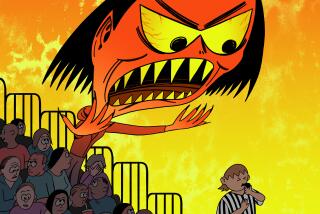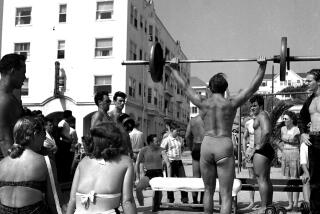Some Ways to Get Your Child Off the Couch and Into Shape
- Share via
The adults of America are on a fitness kick--jogging, swimming, biking, pumping iron, filling up health clubs and making sports-shoe manufacturers rich. Mornings, you find us in the malls, walking briskly. Evenings, we’re on the street, marching off our low-fat, high-fiber dinners.
The children of America are different.
“The fitness boom has not filtered down to children,” declares Raymond Stinar, associate professor of physical education at Maryland’s Towson State University. Studies by the federal government, by the physical education teachers of America and by private researchers show that too many of our children are overweight, inflexible, muscularly weak and lacking in aerobic endurance.
They can’t run for 20 minutes, haven’t the upper-body strength for push-ups and chin-ups, aren’t flexible enough to touch their toes when they sit on the floor with their legs straight out in front of them.
In fact, Stinar says, the tests that determine youngsters’ status actually might be adding to the problem: Children who couldn’t achieve high performance scores might have been turned off from activity.
“The reason the fitness boom for adults took off is that the activities are basically non-competitive; people could use themselves as the standard,” explains Charles Kuntzleman, a Michigan-based physical educator, author and creator of fitness curricula. “But with kids, we haven’t done that. We’re setting them up for failure because we’re always trying to get them to excel.”
The sociological situation has also made them sedentary. They’re bused to and from school, they sit all day at their desks and then go home and sit some more in front of a TV, video game or computer. A lot of parents consider that safer than having their children playing on streets or playgrounds.
Mothers, who might have supervised the play a generation ago, are working themselves now. And fathers, who used to have evenings Think about it: When was the last time you saw the kids in your neighborhood lined up to jump double-dutch or red-hot-peppers? Or watched them race a football across three back yards? Or found a hopscotch they’d chalked on the sidewalk?
and weekends off for family fun and games, are now helping with the housework and grocery shopping.
But the situation isn’t entirely bleak.
“About 20% of children have adopted a healthy life style,” Kuntzleman says. “They’re involved in sports. They’re running, swimming, going to programs at the Y, getting quality physical education at school. And if you banned physical education from the schools, that 20% would still find a way to be active.”
There are no hard-and-fast rules, of course, but to many observers it seems that a lot of the active youngsters have active parents.
“When mom and dad are involved in activity, that’s a life style they pass on to the children,” says Neal MacDonald, director of operations at Baltimore’s Union Memorial Sports Medicine Center.
Stinar agrees: “If a parent wants to produce fit kids, he or she has to be involved.”
That means going out and biking with them instead of taking them to the fast-food store in the car. It means the whole family walking in the evenings instead of plopping down on the sofa to watch TV. And it may also mean playing with them instead of just telling them to go play.
Chances are, they don’t know how.
Think about it: When was the last time you saw the kids in your neighborhood lined up to jump double-dutch or red-hot-peppers or other rope-jumping games? Or watched them race a football across three back yards? Or found a hopscotch they had chalked on the sidewalk?
“Kids are poor game-players,” Stinar says. “They don’t know how to play by themselves or in small groups. We’ve organized all their free time for them.”
Physical education teachers can, of course, teach games and encourage lifetime, non-competitive activities. But when P.E. classes meet no more often than twice a week in most elementary schools, teachers just don’t have enough time to create fit kids, Stinar suggests. Parents must find a way to pick up the slack--and not, the experts say, by setting up more league-type sports.
“Kids should play with other kids. The idea is to have parents give them instruction and occasionally do family things,” says Kuntzleman, whose book, “Healthy Kids for Life,” urges parents to build fitness activities into their children’s lives.
Give them bikes and Pogo sticks, he suggests. Celebrate their birthdays with an activity, rather than just ice cream and cake. Spend part of your vacation time in a family activity--swimming, sailing, walking, backpacking. Help the junior jocks find the right sport, which might not be your sport or another child’s sport, and show the less-athletic kids the joys of non-competitive activities in which the goal is to increase endurance rather than to win races. Reward progress with a T-shirt or sweat band, “which really rings the kid’s bell,” he advises, but don’t try to push your children to do more than their minds and bodies can handle.
“The 4-, 5-, 6-year-old can’t run three miles,” he warns. “But he can spend some time on his scooter, and some on his bike, and run for a while, too, and cover the distance.”
Reward activity with more activity, suggests Linda Vanderhoff, executive director of the Maryland Commission on Physical Fitness. Have everyone in the family establish a personal goal--an increase in time or distance walked, for instance--and when they have all met it, celebrate with a family hike or visit to the zoo.
Unstuff your shirt and join the games. “You’ll find it’s fun, the children will enjoy it and activity will continue,” Stinar says.
There are just a couple of cautions.
“Some people would argue that kids could get hurt doing adult activities,” MacDonald says. “But for the most part, kids will stop if they start feeling uncomfortable or bored. I think kids’ bodies are a little more ‘forgiving’ than adults’ bodies. It’s probably safer for kids to do adult sports than for adults to do kids’ sports.”
“At 6, 7, 8 years old, a child can jog so long as he doesn’t push himself to the point that it’s too intense, or that it’s drudgery,” Stinar says. “A lot of research has shown that strenuous activity doesn’t harm kids, but that if they’re not enjoying it, it can turn them off.”


